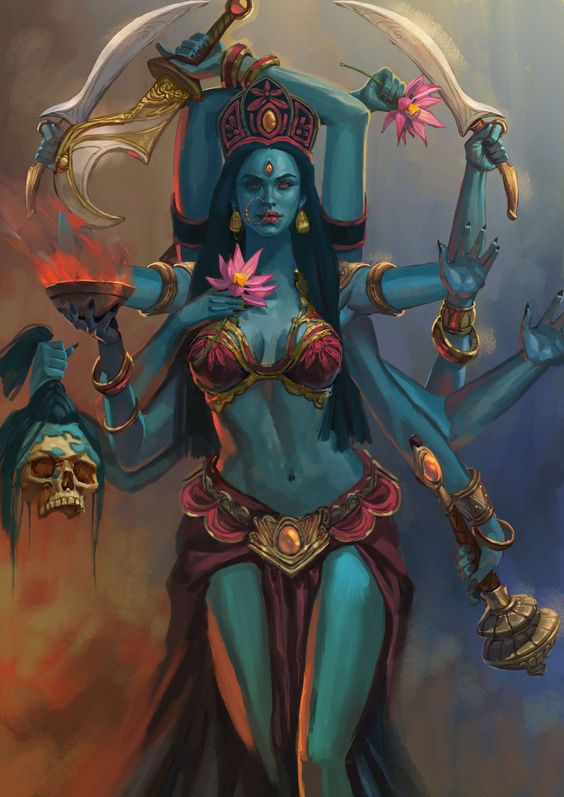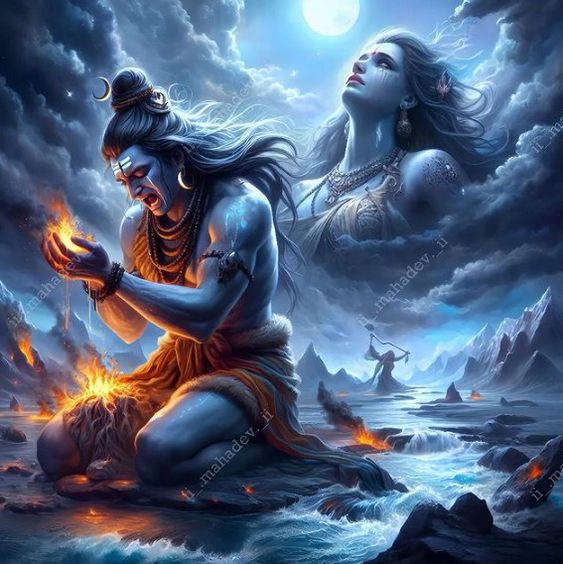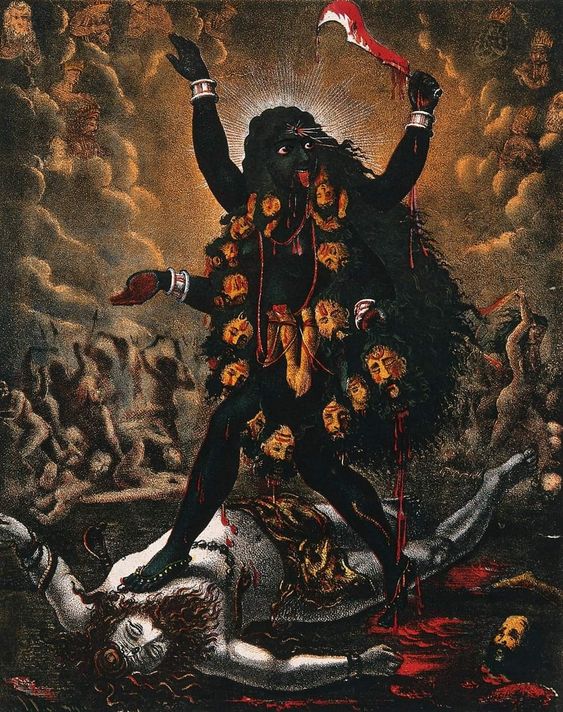After Hindu Gods were ATTACKED by Raktabija, Gods became weak.
Only "Maa Durga" could help them & fight Raktabija. So she took her DEADLIEST avatar & KILLED him, but her BLOODLUST got out of control.
Even Shiva couldn't stop her RAGE so he 'surrendered' to save the universe...
Only "Maa Durga" could help them & fight Raktabija. So she took her DEADLIEST avatar & KILLED him, but her BLOODLUST got out of control.
Even Shiva couldn't stop her RAGE so he 'surrendered' to save the universe...

Maa Durga.
Chamunda. Bhadrakali. DakshinaKali. Mahakali.
Kali Maa.
The most fierce of all gods in Hindu history is not Mahadev, but her consort, Kali Maa.
This story of “Kali dancing on Shiva’s chest” symbolizes the divine destruction and recreation of the universe…


Chamunda. Bhadrakali. DakshinaKali. Mahakali.
Kali Maa.
The most fierce of all gods in Hindu history is not Mahadev, but her consort, Kali Maa.
This story of “Kali dancing on Shiva’s chest” symbolizes the divine destruction and recreation of the universe…


The story begins with Raktabija ("Seed of Blood" in Sanskrit), a formidable demon (asura) in the Devi Mahatmya from Markandeya Purana. Raktabija was granted a boon by Brahma, the creator god, which made him nearly invincible in battle.




According to the Vardhan: Every drop of blood that fell from Raktabija's body upon being wounded would give rise to another Raktabija, possessing the same strength and valour as the original. This extraordinary ability made him a formidable opponent.




Raktabija's unique power caused havoc in the universe, as he waged war against the devas (gods), his ability to multiply from his blood made him nearly impossible to defeat. The gods, finding themselves powerless against Raktabija, sought the help of Maa Durga...




Maa Durga, engaged in a fierce battle with Raktabija, found herself in a challenging position due to Raktabija's multiplying boon. As the battle raged on and the situation became increasingly dire, Maa Durga, in her fierce form, manifested the DEADLIEST form from her forehead...




KALI.
Kali emerged as a dark, emaciated figure with a lolling tongue and a garland of demon heads around her neck. She was the embodiment of Durga's wrath, a warrior goddess created with the sole purpose of defeating Raktabija.
Kali emerged as a dark, emaciated figure with a lolling tongue and a garland of demon heads around her neck. She was the embodiment of Durga's wrath, a warrior goddess created with the sole purpose of defeating Raktabija.

Kali's appearance was terrifying: she had wild hair, and bloodshot eyes, and bore weapons in her many hands. Her most distinguishing feature was her long, outstretched tongue, designed to catch the blood of Raktabija and prevent it from reaching the ground.




Kali, with her ferocious form and indomitable spirit, engaged Raktabija in battle. Understanding Raktabija's boon, Kali devised a strategy to counteract his ability to multiply. As she fought Raktabija and his clones, she used her extended "tongue" to catch every drop of blood that spilt from their wounds, drinking it before it could touch the ground.



This approach effectively neutralized Raktabija's boon, as no more clones could be created from his spilt blood. Deprived of his ability to multiply, Raktabija became vulnerable. Kali, in her fierce form and with her unmatched prowess, finally succeeded in slaying Raktabija. The defeat of Raktabija by Kali marked a significant victory for the gods and Goddess Durga.

But the victory over Raktabija was not the end.
Kali's BLOODLUST had not been sated, and she began a terrifying dance of destruction, trampling over the corpses of the slain demons. Her dance became so wild and uncontrollable that it threatened to destroy the entire world.


Kali's BLOODLUST had not been sated, and she began a terrifying dance of destruction, trampling over the corpses of the slain demons. Her dance became so wild and uncontrollable that it threatened to destroy the entire world.


Understanding the gravity of the situation, Lord Shiva, Kali's consort, decided to intervene to prevent the further destruction of the universe. Shiva is often regarded as the ultimate yogi who embodies the consciousness that underpins all existence. 

His decision to lie down among the corpses on the battlefield was a calculated act to bring Kali's rampage to a halt. Shiva realized that only an act of profound humility and surrender could counteract the intense energy of Kali's fury.




Kali's bloodlust was not merely a thirst for violence but a manifestation of cosmic justice, eliminating all forms of evil and adharma (unrighteousness). Even after the Raktabija was killed, her continued dance of destruction threatened the very balance of the cosmos.




As Kali danced wildly, she inadvertently stepped on Shiva's chest. The moment her foot touched him, she was jolted out of her bloodlust. This sudden realization brought her back to her senses, and her tongue protruded in astonishment and embarrassment. The act of stepping on Shiva, her divine consort, was an act of dishonour in the cosmic play of roles, where Shiva is revered as the supreme consciousness.

The act of Kali stepping on Shiva and the subsequent embarrassment carries profound symbolism. It represents the moment when the force of destruction (Kali) recognizes the supremacy of the underlying divine consciousness (Shiva). It highlights the necessity of balance between the forces of creation and destruction. Shiva lying motionless symbolizes the passive aspect of the divine, the unchanging reality upon which the dynamic universe dances.





Kali's dance on Shiva's chest and her subsequent realization serve as a cosmic pause, reinstating the balance between creation and destruction. It symbolizes the momentary triumph of consciousness over the forces of ignorance and ego. The imagery of Kali and Shiva in this narrative is a powerful reminder of the interdependence of the dynamic and static aspects of the universe, the play of energy and consciousness, and the need for harmony between the forces of nature and the underlying spiritual reality.



This moment, where Kali stands with her foot on Shiva's chest and her tongue out, as the iconic pose we know from our ancient Hindu art and history.
The union of Shiva and Kali is a fundamental aspect of Hindu philosophy, illustrating the interconnectedness of all aspects of the universe. It teaches the importance of respecting both the creative and destructive forces of nature and the need for balance in life. Their relationship is a reminder of the transient nature of the physical world and the eternal, unchanging nature of the spiritual realm.

The union of Shiva and Kali is a fundamental aspect of Hindu philosophy, illustrating the interconnectedness of all aspects of the universe. It teaches the importance of respecting both the creative and destructive forces of nature and the need for balance in life. Their relationship is a reminder of the transient nature of the physical world and the eternal, unchanging nature of the spiritual realm.


Indian history is filled with such grand stories, never to be forgotten.
We @iKyu_HQ worship the delicacy of history in India and stand to flourish it to the world...
Our handKrafted documentary-style breakdowns are ready!
Experience us at ikyu.ink
We @iKyu_HQ worship the delicacy of history in India and stand to flourish it to the world...
Our handKrafted documentary-style breakdowns are ready!
Experience us at ikyu.ink
Follow @VivanVatsa for more doses of brutal breakdowns, history, research and philosophy.
https://x.com/VivanVatsa/status/1759280991116435483?s=20
• • •
Missing some Tweet in this thread? You can try to
force a refresh






























